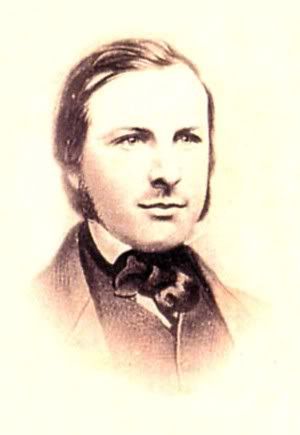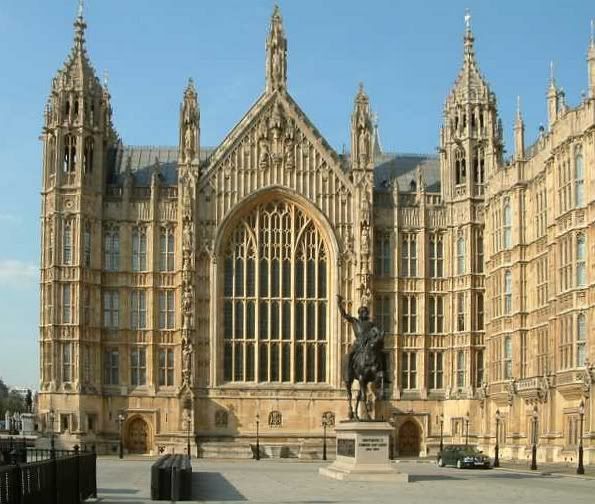
The Gothic Revival in architecture was one of the cornerstones of the Pre-Raphaelite and Arts and Crafts movements. And while many people familiar with the Arts and Crafts movement associate Gothic Revival with Ruskin and Morris, Augustus Welby Pugin was actually England's leading exponent of Gothic Revival in the 19th century. It was Pugin's unique, moral and artistic interpretation of the medieval period that had the greatest influence on the Arts and Crafts Movement.
The other day we examined Horace Walpole's mini Gothic revival in the 18th century. Walpole did a great deal to re-popularize Medieval style, but he knew little about architecture and his "Gothick" mansion at Strawberry Hill was about as authentic as Cinderella's castle at Disney World. So while Walpole is considered by some to be the father of Gothic revival, it's a comparison somewhat akin to calling Marie Antoinette the mother of rural revival because she constructed a play village at Versailles.
It was not until the 19th century that a more heartfelt champion of Gothic style was born. Augustus Welby Pugin was born in 1812 in London in a family of exiled Gallic Aristocrats who had fled the French Revolution. The elder Pugin worked as a draftsman for the architect John Nash. His son exhibited a natural talent at drawing and his sketches were so popular that he was chosen to design furniture for Windsor Castle at the tender age of 19! Shortly thereafter, he went into business for himself.
Pugin was the polar opposite of Horace Walpole, whose interest in Gothic style was more for entertainment value. Pugin represented the new wave of Gothic revival in the 19th century, because he saw Medieval design elements as a moral force.
Pugin converted to Roman Catholicism in his adulthood, and his conversion experience motivated him to express his faith through architecture. Unlike Walpole, who toyed about with Gothic style as a plaything, Pugin idealized the Middle Ages for its intertwining of faith and beauty. In 1836, Pugin synthesised his thoughts about the moral superiority of the Middle Ages in a book entitled Contrasts, A Parallel between the Noble Edifices of the 14th and 15th centuries and Similar buildings of the Present Day. Showing a Decay of Taste . 
Pugin's writings struck a chord with his 19th century audience and he soon received a number of commissions. Pugin is best known for designing the interiors of the Palace of Westminster (Parliament, shown right) in London. His greatest contribution, though, was the way he recast the medieval as a moral force, something that inspired John Ruskin, and later William Morris.
Sadly, Pugin had a nervous breakdown while trying to prepare the Medieval exhibit for the Crystal Palace exhibition of 1851. He was institutionalized briefly, but was released to die at home in 1852.
For more information, see the Pugin Society. Sadly, I took a look at Project Gutenberg, and it doesn't look like any of his works are available online yet! This is a project for somebody! I would really love to read his books, and I'll definitely be posting a review once I do.
Monday, April 21, 2008
Gothic Revival in Architecture and Augustus Welby Pugin
Posted by
Margaret
at
9:06 AM
![]()
![]()
Labels: architecture, medieval, philosophy, william morris
Subscribe to:
Post Comments (Atom)


4 comments:
Another wonderful post Margaret! Have you seen the 60 minutes coverage on the lost Leonardo da Vinci painting?
xx Nancy
hi Margaret! i've got 2 awards for you, so sorry i cd not link it bcos am will be off soon and internet-less, + got a very long list of linking too. guess what, a few more goth infor from you and i'll be the most informed person in malaysia on this subject..they dont read much or know anything here on the subjcet :) and love the building. will be hopping over soon :)
This post brought back fond memories of my first trip to London back in the 80's. I traveled to England all by lonesome and toured the magnificent Parliament buildings on one bleak rainy day. I remember being sick with the flue and standing transfixed at my surroundings, never knowing at the time who was responsible for such marvelous interiors!
All this talk of London and Paris. Lucky you! You're making this old ex-flight attendant wistful to win the lottery so I can get back out there into the wide wonderful world.
May I be so bold as to presume that you will be taking many pictures to share with us afterwards?
oops Margaret, I had to have a fairly urgent rethink about Pugin and Crystal Palace, as you will see. This link business is wonderful :)
regards
Helen Webberley
http://melbourneblogger.blogspot.com/
Post a Comment